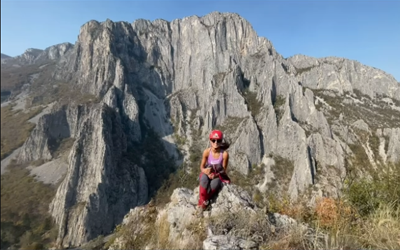Date: 07 Apr 2024
1 . Introduction
This article focuses on altitude-specific topics for women and reflects the official UIAA MedCom standard recommendation, which is based on current literature.
2 . Non pregnant women
2.1 . AMS (Acute Mountain Sickness)
- There is no difference between men and women in the incidence of OPD.
- The incidence of High Altitude Pulmonary Edema (HAPE) is lower in women than in men [1].
- The incidence of peripheral edema is more common in women than in men [2].
- There is no reported difference between men and women in the manifestation of High altitude cerebral edema (HACE)/.
- Although progesterone increases the hypoxic ventilatory response at sea level, there are no data to suggest a correlation between acclimatization to high altitude (HALE) and phases of the menstrual cycle.
2.2 Menstruation and perimenopausal hypermenorrhoea
- Menstruation can be altered by GD: menses can be blocked, longer, shorter or irregular. Among other causes, and probably more important than altitude, it can be affected by overwork, exercise, cold and weight loss.
- To avoid or significantly reduce bleeding, oral contraceptives (OCPs) or progesterone (pills, medroxyprogesterone injections, or an intrauterine device (IUD)) can be taken continuously for several months (but bleeding may occur during the first 3 months).
2.3. Oral contraceptives
- There is no proven advantage or disadvantage in altitude acclimatization when oral contraceptives (OCPs) are used.
- The theoretical risk of oral contraceptives (with the exception of progesterone only) is thrombosis with prolonged exposure to high altitude, in combination with polycythemia, dehydration and cold. Very few incidents have actually been reported. The risk is lower with second-generation oral contraceptives (compared with first- or third-generation), which are recommended as the first choice at high altitude but with
these these tablets in a small dose the following two risks should be considered:
- It may be difficult to maintain an accurate schedule during an expedition and compromise contraceptive effectiveness.
- Efficacy may also be compromised during and 7 days after the use of some antibiotics, especially broad-spectrum penicillins and tetracyclines.
2.4. Iron
- Latent iron deficiency can hinder acclimatisation at very high altitudes.
A dose of ferritin may be useful before the expedition as a supplement.
3. Pregnant women
3.1. Risks of travelling to distant and exotic countries
- Distance from medical/obstetric care
- Infectious diseases can be more severe during pregnancy: especially diarrhoea, malaria, hepatitis E.
- Some drugs that are useful for prevention or treatment are contraindicated during pregnancy: most antimalarials, quinolones, sulfonamides, etc.
3.2. Hypoxia risk
Most studies refer to women living permanently at high altitude. For pregnant women living normally at low altitude, very few studies have been done during heavy exposure (hours) at moderate altitude, with or without exercise, and no known study has been conducted during prolonged exposure (days to weeks). So most recommendations can only be based on extrapolations.
3.2.1. Physiological consequences of altitude exposure:
- The immediate increase in maternal ventilation and cardiac output (with increased uterine artery and placental blood flow) preserves, at best, oxygen delivery to the fetus.
- The incidence of OPD (acute mountain sickness) is not different during pregnancy [3]. Acetazolamide use is contraindicated during the first trimester (risk of teratogenicity) and after 36 weeks of gestation (risk of severe neonatal jaundice).
- Adequate hydration due to hyperventilation (altitude + pregnancy) is recommended as the dry environment, at high altitude, will increase hydration requirements.
3.2.2. First half of pregnancy:
- There is little risk with high altitude exposure.
- A higher incidence of miscarriage in the first trimester has been suggested but not proven.
- Recommendation:
- Women who have difficulty becoming pregnant/or are at higher risk of miscarriage should avoid high altitude.
3.2.3. Second half of pregnancy
- Potential high risk to mother and fetus, depending on individual factors, altitude and physical activity.
- Short stay without exercise (a few hours to a few days)
- Apparently very low risk in normal pregnancy up to 2500 m, but no data available.
- Altitude is not recommended for women with risk factors (see below), even for short stays.
- Long stays without exercise (weeks to months), above 2500 m
- Mother: higher incidence of hypertension, pre-eclampsia, placental abruption [4].
- Fetus: intrauterine growth retardation during 3rd trimester and low birth weight [5].
- Recommendation: careful clinical and echo-Doppler surveillance after the 20th week of gestation.
- Exertion: competition for blood supply between skeletal muscles and placenta.
- Risk of fetal hypoxia or preterm delivery [6].
- Recommendations:
- 3-4 days of acclimatization before exertion above 2500 m.
- Wait for full acclimatization (2 weeks) before heavy loads and avoid heavy loads at higher altitudes.
3.2.4 Contraindications to altitude during pregnancy (after the 20th week) [7]
- Chronic or pregnancy-induced hypertension.
- Abnormal placental function (ultrasound diagnosis).
- Intrauterine growth retardation.
- Maternal heart or lung disease.
- Anaemia.
- Smoking in combination with exertion is a high risk factor and may be contraindicated.
3.2.5 Risk of trauma
Beware of changes in centre of gravity and joint laxity during pregnancy predisposing to falls and trauma, with potential risk of placental abruption (e.g. during skiing). Take care to adjust the climbing seat well.







Post comment